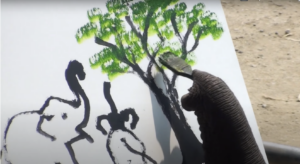Intellectual property law assumes a rightful owner because inventions have rightful designs behind them: creators, or intelligent designers. However, what if products are no longer intelligently designed, but blindly evolve? In such a world, public ownership makes more sense than private ownership. Evolutionary algorithms are, right now, building such a world. In short: evolutionary algorithms are undermining private ownership. For, as more and more products become auto-generated, something—namely, private ownership claims—will have to give.
Evolutionary algorithms can generate shoes, desks, and stock-images. Evolutionary algorithms even have a hand in designing intricate products, from aeroplane parts to computer chips (Mitchell, 2009). Some algorithms print whole buildings. The future of evolutionary design therefore looks bright.
These algorithms are just computer programs, or fancy recipes, which recombine old ingredients many times over to create ‘new’ products. They recombine inputs to generate different outputs hundreds, thousands, and millions of times over, in fact. Until they converge on forms which please their instigators, or meet their wants. Including wants, they sometimes had no clue they wanted. These algorithms throw-up serendipitous solutions, and plagiarise nature in the process. By mimicking evolution’s iterations they bypass the traditional need for a designer, inventor, author, or artist, at all, coming up with eccentric designs no human could picture, let alone put onto a blueprint, a canvas, or code into a bioinformatic drug.
The algorithms, of course, have no ownership rights. They are not legal persons. The persons who instigate their iterations however stake a claim to own their ultimate outputs. Thus a company which owns the algorithms (software) and printer (hardware) to generate a house, for example, takes value from people who pay for the privilege, makes value in a cheaper house build; and destroys value in cutting builders’ work hours and their wages-to-then-spend. This disrupts the economic circle where one man’s spending (a house commissioner) is another woman’s income (a builder). This lopsided example is indicative of a trend towards rentier capitalism (Christophers, 2022) where owners claim profit for what requires no labour and no commensurate investment on their side.
Such mechanised rent seeking has a long history. Indeed a history from when mass production picked up steam. Oscar Wilde lamented rent-seeking automation in The Soul of Man Under Socialism (Wilde, 2021), declaring how “One man owns a machine which does the work of five hundred men. Five hundred men are, in consequence, thrown out of employment, and, having no work to do, become hungry and take to thieving. The one man secures the produce of the machine and keeps it, and has five hundred times as much as he should have”.
Ownership is, remember, meant to be predicated on design, effort, or return on investment (Mirowski, 2013; Pistor, 2019) and patent law on originality, non-obviousness, and usability (Parthasarathy, 2017). These tenets are often treated as if they were natural laws inherent to inexorable economics; the aura of scientific objectivity lends invention and patents a glowing light (Parthasarathy, 2017). It is ironic therefore that the artifice of invention and ownership is now flummoxed by natural law and chance recombination; where once was invention and an inventor, there is now evolutionary discovery and a chance discoverer. Historically, many supposed inventions came to be assuredly, separately, and repeatedly. Discoverers discovered the components to make The Lightbulb separately 23 times; farming separately 11 times; packet-switching (a technology which enables internet data transfer) separately twice; jet engines separately twice; television separately thrice; the contraceptive pill separately thrice; and the theory of evolution by natural selection, itself, was discovered independently twice, by Charles Darwin and Russell Wallace (Bijiker, n.d.; MacKenzie & Wajcman, 1999; Ridley, 2020). Much as evolution discovered The Eye separately on different evolutionary branches as it converged on the same solution to the same problem (seeing), artificial ‘inventions’ emerged and converged separately in different environments. And will do so again. Natural selection and artificial engineering might seem so different as to be incommensurate, but the lines do in fact blur.
Richard Dawkins, the evolutionary biologist, explains in The Blind Watchmaker how what appears to be intelligent design is but chance recombination navigating natural constraints. Dawkins runs his biomorph algorithm evolving tree, beetle, insect, fish and flower-like forms; see below.
Algorithmically generated and evolved biomorphs (Dawkins, 1996)
It is as though the forms are dormant, waiting to be discovered by chance rather than by design. Hence the thesis: devices more complex than watches discover themselves. They blindly evolve.
The biomorphs evolve and evolve much as actual creatures, like monkeys and elephants, evolve: from the patterns that are available, permissible, and recombinable. There are constraints for what can emerge; constraints on how big an animal can be, for example, which are revealed in what has evolved before. Dawkins describes this poetically as The Design Space: the total possible space into which things can evolve. The history of The Design Space shows its limits: there are just 400 shark species (no more, no fewer) the biggest of which is the prehistoric Megaldon which is three times larger than a Great White Shark (and no bigger). Just as there is a design space for natural evolution, there is a design space for algorithmic evolution, which puts pay to the idea of invention being merited on any appeal to genius or one-time ‘original’ achievement.
Consider The Next Rembrandt, an example credited to my friend Chris Neels. It is a painting generated from algorithms which mimic the Dutch Renaissance painter Rembrandt in exquisite detail. The output derives from its computer program and a 3D printer, but the inputs originate from Rembrandt’s paintings. His colour pigments and brush strokes were the training set which rendered ‘the Next Rembrandt’. Since the painting is 3-D printed, everyone with the right printer can be a co-owner; it has no monopoly value at all. No author, and no owner, and the training set associated with the deceased Rembrandt can (quite reasonably) no longer be said to be monopolised by him. His paintings are no longer his, but a style, a format.
Similarly, animal paintings are sold by the animals’ owners, despite the unique selling point being that animals have painted them. Suda the Thai elephant, for example, paints impressively pretty pictures.

This is a piquant example because the locus of ownership is not in either case that of an intelligent designer, like Rembrandt or Suda, but to owners behind materials, such as having paints and paper or having patterns and printers. But in both cases the material owner is substitutable and inessential; someone else can run the program and switch on the printer, likewise someone else can furnish an elephant with painting materials and compel it to paint. The key point is, nevertheless, the decoupling of creation from a human creator, without which ownership is truly tenuous. What place do patents and owners’ rights have if creations lack no human inventors, designers, or authors? The case of elephants’ artwork and algorithms artwork are indeed analogous: no humans were involved, beyond nudging the creative ball to roll into new paths of The Design Space. Owners in such a case are taking value from the semi-random production of machine or animal intelligence, not making value from their own.
As the logic of The Design Space becomes more obvious to consumers and producers, then, intellectual property may well become disreputable. One cannot monopolise The Chair, The Knife, The Lightbulb, or The Painting as species—or types—because people naturally converge on such ‘inventions’; though one can monopolise particular instantiations. If that instantiation happens by chance, however (as argued, here) that ownership claim becomes onerous to sustain.
There is nothing natural or de-facto rational about patent ownership. Just think of Tim-Berners Lee and his team who made the world-wide-web (WWW) who never patented their inventions. If they were working for profit, they would never have been allowed the risk-taking and speculative investment for the web to emerge (Mazzucato, 2013).
The case of patented drugs in re-generative design is a more pressing example. A study, spanning from 2005 to 2015, in the Journal of Law and Biosciences concluded that “Rather than making new medicines, pharmaceutical companies are largely recycling and repurposing old ones. Specifically, 78% of the drugs associated with new patents were not new drugs, but existing ones, and extending protection is particularly pronounced among blockbuster drugs” (Feldman, 2018).
For companies to keep making profits for innovation they have to create new drugs, but if their inventions are made by recombining into new forms the idea of novel invention commensurate with patent protection—and authorship per se—becomes questionable in itself.
Furthermore, US National Institutes of Health funding supported the basic research behind all 210 new drugs the Food and Drug Administration approved between 2010 and 2016, for another example, so the idea that patents for private business foster innovation, and thereby public welfare, is doubtful.
As Philip Mirowski outlines in Science Mart (Mirowski, 2011) public money funds science but private interests, universities and companies, profit from monopolising discoveries they merely happen to come upon first. Two economists reviewed the patent system for the United States’ Federal Reserve (The Case Against Patents, 2012.) and concluded that patents were a negative: “there is no empirical evidence that they serve to increase innovation and productivity. There is strong evidence, instead, that patents have many negative consequences.” Historically, too, countries with fewer patents have fared as well as those with strong patents, guarded within them (Moser, 2012). Competition powers innovation far more than the protection of incumbent owners.
Conclusions
If oligopolies like Big Tech and Big Pharma and Big Agri, own the software—the bound recipe books—which generate products from recombination, it does not follow that they deserve ultimate ownership over their proximate products, any more than recipe book authors deserve ultimate ownership of their readers’ meals.
Dormant within The Design Space there are possible permutations for each design. A warranted and scientific look at that fact, reveals how ideological-rather-than-factual is the business of patent design, ownership, and commission. Just as a rose, an elm, or a shark exist without invention but selective negotiation with the environment, so too do algorithmically generated products exist because they are chanced upon. They exist in the remit of material possibilities already. Who gets rewarded, if anyone, when no ‘who’ is behind it; that is up for debate. Fewer people believe in giving dues to God (the ultimate owner) for his designs, because they think designs just evolve. What if algorithms likewise evolve products without any Creator due deferential credit—and financial reward—for making it all happen. Algorithms are in a sense therefore against owners, despite their owners’ self-serving protestations to the contrary. Because such generative algorithms erode the importance of invention and private monopoly, and instead show shared discovery in action, which invites us to discover, in turn, exactly what forms of ownership are out there, waiting to be discovered.

